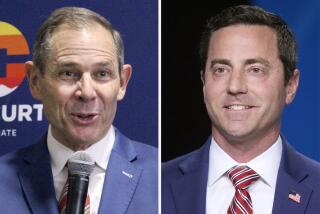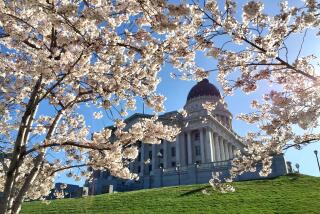As World Stage Awaits, Curtain of Haze Drops on Salt Lake City
- Share via
SALT LAKE CITY — It’s all here for Olympic visitors to view: an impressive downtown skyline and an equally stunning ring of snowy mountains. If only they were visible.
Just when civic boosters hoped that the host city would sparkle, the meteorological phenomenon known as “temperature inversion” hit town. The condition has gripped the Salt Lake basin for more than a week--trapping frigid air and pollution into a murky mass of cold and foul air. The inversion has enveloped the region in a viscous haze that has obscured the city’s pride and joy, its view of the magnificent Wasatch Range.
The filmy outlook is made up of fog, haze and pollution--with a strong dollop of arctic air. It’s not common this late in the season, and it has made for a less-than-welcoming atmosphere for thousands of international visitors: Air quality officials issued alerts for four consecutive days this week, warning of unhealthful conditions. Those venturing out gird themselves for daytime temperatures in the teens. The sun has rarely been glimpsed.
Forecasters are tentatively predicting a storm for the weekend. That should eliminate the stubborn layer of warm air that acts as a lid on colder air. A rind of ice and snow on the ground makes it all worse.
The mountains ringing Salt Lake City turn the cold and murky mess into a dingy blanket covering the city. Such conditions are a regular feature of mountain cities in winter; Denver is notorious for its “brown cloud.”
The severe weather is evidence that these are, indeed, the Winter Olympics. Officials are warning those attending tonight’s opening ceremony to bundle up. Snow is predicted.
“If you pay $885 for your opening ceremony ticket and go to the stadium in tennis shoes, you are in trouble,” said Olympic organizer Mitt Romney. “You are going to have to make a decision: Your toes or your ticket investment. It’s not a choice you want to have to make.”
Romney made the comments at an unusual news conference in which he lectured on meteorology and displayed props that included thermal underwear and heavy boots.
“This is the worst,” said Larry Dunn, the meteorologist in charge of the National Weather Service office here. “If you could think of weather conditions that would give a visitor the worst impression of Salt Lake, this is it. If the storms come in as expected, it would be very dramatic. All of a sudden you would see the Wasatch in all its glory.”
Dunn said that inversion normally occurs in December and January and that the timing and the length of the current condition are atypical. The region has been hit with an unusually cold and snowy winter: In November, 20 feet of snow fell in Cottonwood Canyon, and 100 inches fell in 100 hours at the Alta ski area, both to the southeast.
Along with trapping cold air, inversion also allows polluted air to collect, rendering the atmosphere hazy and unhealthful.
Dianne Neilson, executive director of the Utah Department of Environmental Quality, said her office has issued at least five days of “red burn” alerts, meaning no wood may be burned in fireplaces or wood stoves.
She has also issued an alert in two counties to advise young children and the elderly to stay indoors and for healthy individuals to limit strenuous outside activity.
All of which could be problematic for the thousands of high-performance endurance athletes here. Anyone with asthma or a respiratory condition--even a cold--is susceptible to the crummy air.
Dr. Dan Carr, head physician for the U.S. Olympic Team, is well versed in the vagaries of Salt Lake’s climate. He was a self-described ski bum here before attending medical school and later served his surgical internship here.
“I’m aware of inversion, and at this stage we are not concerned,” Carr said. He pointed out that many Olympic events take place out of the valley murk and in the mountains where the air is thin but clear. Those athletes competing in Salt Lake do so indoors, where air is filtered.
It’s not the picture anyone here wanted to present to the world.
“It’s gross and I hate it,” said Liz Fitzgerald, who works at a local deli. “It’s too bad this is what people think Salt Lake looks like. If they can see it.”
More to Read
Go beyond the scoreboard
Get the latest on L.A.'s teams in the daily Sports Report newsletter.
You may occasionally receive promotional content from the Los Angeles Times.







